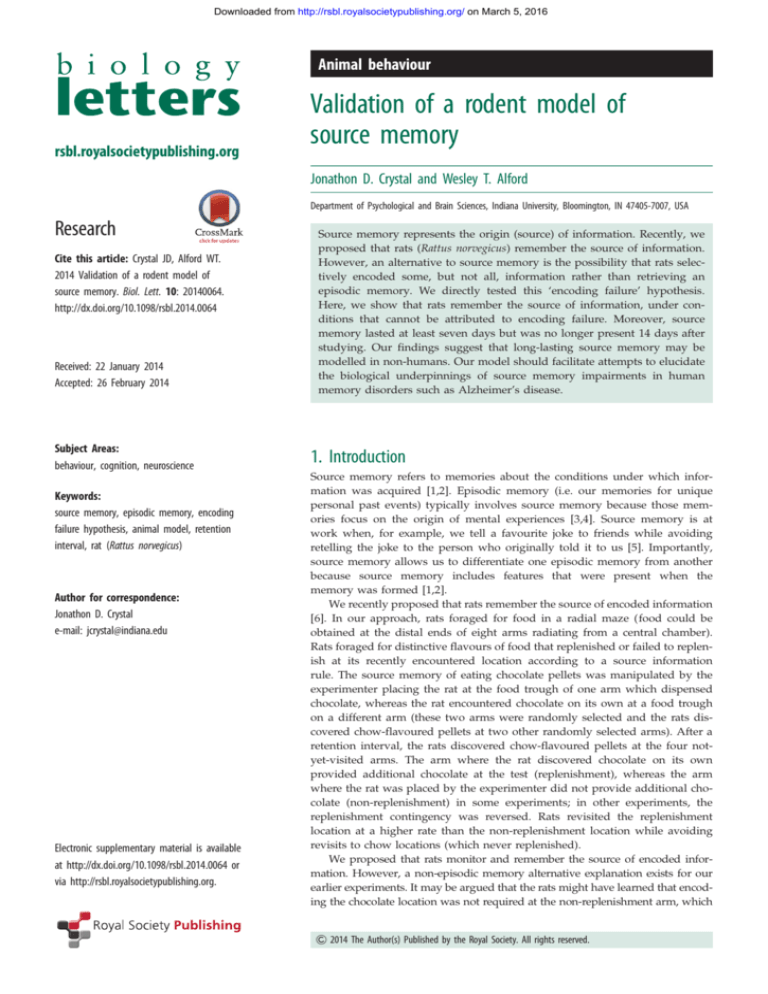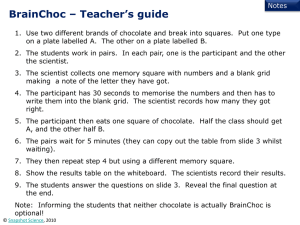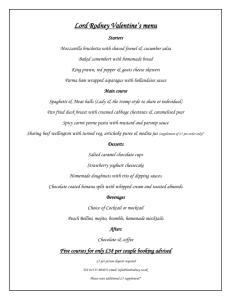
Downloaded from http://rsbl.royalsocietypublishing.org/ on March 5, 2016
Animal behaviour
rsbl.royalsocietypublishing.org
Validation of a rodent model of
source memory
Jonathon D. Crystal and Wesley T. Alford
Department of Psychological and Brain Sciences, Indiana University, Bloomington, IN 47405-7007, USA
Research
Cite this article: Crystal JD, Alford WT.
2014 Validation of a rodent model of
source memory. Biol. Lett. 10: 20140064.
http://dx.doi.org/10.1098/rsbl.2014.0064
Received: 22 January 2014
Accepted: 26 February 2014
Subject Areas:
behaviour, cognition, neuroscience
Keywords:
source memory, episodic memory, encoding
failure hypothesis, animal model, retention
interval, rat (Rattus norvegicus)
Author for correspondence:
Jonathon D. Crystal
e-mail: jcrystal@indiana.edu
Electronic supplementary material is available
at http://dx.doi.org/10.1098/rsbl.2014.0064 or
via http://rsbl.royalsocietypublishing.org.
Source memory represents the origin (source) of information. Recently, we
proposed that rats (Rattus norvegicus) remember the source of information.
However, an alternative to source memory is the possibility that rats selectively encoded some, but not all, information rather than retrieving an
episodic memory. We directly tested this ‘encoding failure’ hypothesis.
Here, we show that rats remember the source of information, under conditions that cannot be attributed to encoding failure. Moreover, source
memory lasted at least seven days but was no longer present 14 days after
studying. Our findings suggest that long-lasting source memory may be
modelled in non-humans. Our model should facilitate attempts to elucidate
the biological underpinnings of source memory impairments in human
memory disorders such as Alzheimer’s disease.
1. Introduction
Source memory refers to memories about the conditions under which information was acquired [1,2]. Episodic memory (i.e. our memories for unique
personal past events) typically involves source memory because those memories focus on the origin of mental experiences [3,4]. Source memory is at
work when, for example, we tell a favourite joke to friends while avoiding
retelling the joke to the person who originally told it to us [5]. Importantly,
source memory allows us to differentiate one episodic memory from another
because source memory includes features that were present when the
memory was formed [1,2].
We recently proposed that rats remember the source of encoded information
[6]. In our approach, rats foraged for food in a radial maze (food could be
obtained at the distal ends of eight arms radiating from a central chamber).
Rats foraged for distinctive flavours of food that replenished or failed to replenish at its recently encountered location according to a source information
rule. The source memory of eating chocolate pellets was manipulated by the
experimenter placing the rat at the food trough of one arm which dispensed
chocolate, whereas the rat encountered chocolate on its own at a food trough
on a different arm (these two arms were randomly selected and the rats discovered chow-flavoured pellets at two other randomly selected arms). After a
retention interval, the rats discovered chow-flavoured pellets at the four notyet-visited arms. The arm where the rat discovered chocolate on its own
provided additional chocolate at the test (replenishment), whereas the arm
where the rat was placed by the experimenter did not provide additional chocolate (non-replenishment) in some experiments; in other experiments, the
replenishment contingency was reversed. Rats revisited the replenishment
location at a higher rate than the non-replenishment location while avoiding
revisits to chow locations (which never replenished).
We proposed that rats monitor and remember the source of encoded information. However, a non-episodic memory alternative explanation exists for our
earlier experiments. It may be argued that the rats might have learned that encoding the chocolate location was not required at the non-replenishment arm, which
& 2014 The Author(s) Published by the Royal Society. All rights reserved.
Downloaded from http://rsbl.royalsocietypublishing.org/ on March 5, 2016
chocolate
chocolate
chow
chow
4 min delay
Biol. Lett. 10: 20140064
2. Material and methods
2
first helpings
rsbl.royalsocietypublishing.org
we refer to as the encoding failure hypothesis [7], a form of
selective encoding. Because non-replenishment could be predicted at the time the rat initially encountered chocolate, a
rat might solve the task by encoding the chocolate location when initially discovering the replenishment location
(e.g. when encountering the chocolate on its own), but not
encoding the chocolate location when discovering the nonreplenishment location (e.g. placement by the experimenter).
Importantly, higher revisit rates at the replenishment location
compared with the non-replenishment location would occur
in this situation without the rat remembering the episode.
Here, we tested the encoding failure hypothesis. Our
approach (figure 1) was to provide rats with some information
needed to predict replenishment at the time of encoding
(location, food flavour, source), but one critical piece of information needed to predict replenishment was not presented
until immediately before the memory assessment. We provided
a retrieval cue (the presence/absence of additional chocolate
pellets in the central chamber, counterbalanced across rats)
that was needed to predict replenishment when combined
with source memory; chow-flavoured food was available at
all other locations but never replenished. Thus, to solve the
task, the rats needed to encode location, flavour and source
information at both chocolate locations, but decoding of the
replenishment location was delayed until immediately before
memory assessment. If the encoding failure hypothesis
explained the results from our previous experiments, then it
would be impossible for the rats to solve the current task. By
contrast, if rats used source memory, they should revisit chocolate at a higher rate at replenishment than non-replenishment
locations. Next, we examined source memory using up to
14 day retention intervals. Because source memory, and episodic memory more generally, is a form of long-term memory,
we expect that source memory will survive relatively long
retention-interval challenges.
retrieval cue
second helpings
chow
chow
chocolate
chocolate
chow
chow
chow
chow
chow
closed door
chow
chocolate in hub
Figure 1. Schematic of experimental design showing topographical views of
the maze. For half of the rats, hub baiting with 15 chocolate pellets signalled
that only the self-located chocolate arm would be replenished, whereas hub
baiting with zero chocolate pellets signalled that only the arm where the
experimenter had placed the rat would be replenished; these contingencies
were reversed (not shown) for the remaining rats.
(a) Subjects
Sixteen male Long-Evans rats (Rattus norvegicus; Harlan; 61 days
and 325 g) were individually housed with light onset and offset
at 07.00 and 19.00, respectively; one rat was inadvertently euthanized by a different experimenter, and so the dataset had 15 rats.
They received 45 mg chow and chocolate pellets (F0165 and
F0299; Bio-Serv) during sessions followed by 15 g d21 of 5012Rat-Diet (PMI Nutrition International). Water was ad libitum,
except in the maze.
(b) Apparatus
A radial maze (central chamber and eight arms, each equipped
with a guillotine door, food trough, 45 mg pellet dispenser and
photobeams) was used (see [6,8]).
(c) Experimental procedure
Two experiments were conducted: encoding failure and
retention-interval experiments.
(i) Encoding failure
Pretraining and initial training are described in the Detailed
Methodology section of the electronic supplementary material.
Daily sessions consisted of one trial, but they were divided
across study and test phases as follows: a study phase (first
helpings of food), a retention interval, a retrieval cue ( pellets
or no-pellets in the hub) and a test phase (second helpings of
food). In the study phase (first helpings), doors to four out of
eight arms (randomly chosen for each rat each day) were
opened and closed individually by the experimenter so the rat
would enter a predetermined (randomly selected) sequence of
arms. Controlled access also allowed the experimenter to place
the rat in one of the designated chocolate arms (randomly
selected); the rat was placed at the distal end of the arm near
the food trough and facing the trough and dispenser. Visits to
two of these study arms were reinforced with three chocolate pellets and visits to the other two study arms were reinforced with
one chow pellet. Pellet(s) were delivered to accessible troughs
with the interruption of the trough photobeam. The study
phase ended when food had been dispensed at each accessible
location and then the rat was removed. After a delay of
approximately 4 min, the animal was replaced in the hub for
presentation of retrieval cues; on a daily basis, half the rats (randomly selected) received 15 chocolate pellets in the central hub
and the other half zero pellets. Hub baiting with 15 or zero chocolate pellets was followed by a test phase (second helpings) with
doors to all eight arms opened. In the test phase, one chow pellet
was available in each arm that was not accessible during the
study phase (first helpings); in addition, one of the two studyphase chocolate locations provided three chocolate pellets per
Downloaded from http://rsbl.royalsocietypublishing.org/ on March 5, 2016
Table 1. Accuracy in avoiding revisits to depleted chow-flavoured locations.
Accuracy was measured as the proportion correct in the first four choices
excluding the chocolate locations in a test phase. This analysis of chow
accuracy was restricted to the six non-chocolate arms. The Bayesian expected
value by chance is 0.518. The shortest delay by which chow accuracy dropped
below the 4-min baseline occurred at 4 days (t14 ¼ 4.3, p , 0.001).
***
1.00
0.75
0.50
procedure
0.25
replenish
non-replenish
food in hub
no food in hub
encoding failure
4 min
0.728*** + 0.029
experiment
retention-interval
4 min
0.709*** + 0.027
experiment
(b)
p (revisit chocolate)
1.00
0.75
**
mean + s.e.m.
3h
0.660** + 0.047
1 day
4 days
0.681* + 0.059
0.576 + 0.040
7 days
14 days
0.628 + 0.060
0.550 + 0.061
*p , 0.05, **p , 0.01, ***p , 0.001.
0.50
7 day retention intervals, which was the range we used previously
[6]. Because we did not observe any evidence for source memory
decay in this range, we added the 14 day retention-interval
condition to verify that source memory eventually decays. All
sessions were analysed.
replenish
0.25
non-replenish
0
0 1
4
7
retention interval (days)
14
Figure 2. (a,b) Rats preferentially revisit the chocolate location when it is about
to replenish in (a) encoding failure and (b) retention-interval experiments. The
data are mean with 1 s.e.m.; the probability of at least one revisit to the chocolate location was calculated from the first five choices in memory-assessment
phases (1 if at least one revisit occurred; 0 otherwise). Replenishment is different
from non-replenishment: **p , 0.01, ***p , 0.001. The probability expected
by chance is 0.487 (calculated with a geometric distribution). (a) All values
are above chance ( p , 0.001). (b) Mean across retention intervals less than
14 days are above chance in replenishment ( p , 0.001) and non-replenishment
( p , 0.05); performance is not different from chance at 14 day delay.
visit (second helpings) during up to five visits per chocolate
location. The particular hub-baiting retrieval cue signalled
which study-phase chocolate location would be replenished as
diagramed in figure 1. For half of the rats, hub baiting with
15 chocolate pellets signalled that only the self-located chocolate
arm would be replenished, whereas hub baiting with zero chocolate pellets signalled that only the arm where the experimenter
had placed the rat would be replenished; these contingencies
were reversed for the remaining rats. Initially, the type of hub
baiting was presented in alternating blocks of 4 – 34 sessions,
for a total of 134 sessions. Finally, in mixed testing, the type of
hub baiting was randomly selected each session for a total of
24 sessions with restriction that there be three of each type in
each six-session block and no more than three consecutive sessions of the same type. All mixed-testing sessions were analysed.
Detailed methodology is provided in the electronic
supplementary material.
(ii) Retention interval
The procedure (23 sessions) was identical to mixed testing
described above, except the retention interval was approximately
4 min, 3 h, 1, 4, 7 or 14 days. Short (4 min) and longer retentionintervals were mixed across days. We initially tested 4 min to
3. Results
(a) Encoding failure experiment
When replenishment was decoded by a retrieval cue immediately before memory assessment, rats preferentially revisited
the chocolate location when it was about to replenish
(figure 2a; F1,14 ¼ 21.8, p , 0.001). The type of retrieval cue
(food versus no-food in hub) did not influence revisit rates
(F1,14 ¼ 2.0, p . 0.05) nor did it interact with the replenishment
variable (F1,4 ¼ 1.5, p . 0.05). Differential rates of revisiting
chocolate locations were accomplished while rats accurately
avoided revisits to depleted chow locations (table 1).
(b) Retention-interval experiment
We initially examined retention intervals between 4 min and
7 days, which corresponds to the range previously investigated [6]. Revisits to the replenishment-chocolate location
was higher than to the non-replenishment-chocolate location
(figure 2b; F1,14 ¼ 9.4, p , 0.017). Revisits did not vary across
retention intervals up to 7 days (F4,56 ¼ 1.7, p . 0.05) and
retention interval did not interact with the replenishment
variable (F4,56 , 1, p . 0.05). In contrast to the approximately
consistent source memory performance across retention intervals up to 7 days, chow accuracy declined as a function of
these retention intervals (F4,56 ¼ 3.2, p , 0.05; table 1). Previously, we observed the introduction of source memory
errors with a 7 day retention interval, yet in the present
experiment, there was no evidence for source memory
decay even after a 7 day delay. Thus, we added a 14 day
retention-interval condition, which documented the eventual
elimination of source memory (no difference between replenishment and non-replenishment revisits after a 14 day delay,
t14 , 1).
Biol. Lett. 10: 20140064
0
retention interval
3
rsbl.royalsocietypublishing.org
p (revisit chocolate)
(a)
Downloaded from http://rsbl.royalsocietypublishing.org/ on March 5, 2016
4. Discussion
doi:10.5061/dryad.jq470.
Funding statement. Supported by National Institute of Mental Health
R01MH080052 and R01MH098985 to J.D.C.
References
1.
2.
3.
4.
5.
Johnson MK, Hashtroudi S, Lindsay DS. 1993 Source
monitoring. Psychol. Bull. 114, 3–28. (doi:10.1037/
0033-2909.114.1.3)
Mitchell KJ, Johnson MK. 2009 Source monitoring
15 years later: what have we learned from fMRI
about the neural mechanisms of source memory?
Psychol. Bull. 135, 638–677. (doi:10.1037/
a0015849)
Johnson MK. 2005 The relation between source
memory and episodic memory: comment on
Siedlecki et al. (2005). Psychol. Aging 20, 529–531.
(doi:10.1037/0882-7974.20.3.529)
McDuff SGR, Frankel HC, Norman KA. 2009 Multivoxel
pattern analysis reveals increased memory targeting
and reduced use of retrieved details during singleagenda source monitoring. J. Neurosci. 29, 508–516.
(doi:10.1523/JNEUROSCI.3587-08.2009)
Wright AA. 2013 episodic memory: a rat model of
source memory. Curr. Biol. 23, R198 –R200. (doi:10.
1016/j.cub.2013.01.055)
6.
Crystal JD, Alford WT, Zhou W, Hohmann AG. 2013
Source memory in the rat. Curr. Biol. 23, 387– 391.
(doi:10.1016/j.cub.2013.01.023)
7. Zhou W, Crystal JD. 2011 Validation of a rodent
model of episodic memory. Anim. Cogn. 14,
325 –340. (doi:10.1007/s10071-010-0367-0)
8. Babb SJ, Crystal JD. 2005 Discrimination of what,
when, and where: implications for episodic-like
memory in rats. Learn. Motiv. 36, 177–189.
(doi:10.1016/j.lmot.2005.02.009)
9. Clayton NS, Dickinson A. 1998 Episodic-like memory
during cache recovery by scrub jays. Nature 395,
272 –274. (doi:10.1038/26216)
10. Eacott MJ, Easton A, Zinkivskay A. 2005 Recollection
in an episodic-like memory task in the rat. Learn.
Mem. 12, 221–223. (doi:10.1101/lm.92505)
11. Fortin NJ, Wright SP, Eichenbaum H. 2004
Recollection-like memory retrieval in rats is
dependent on the hippocampus. Nature 431,
188 –191. (doi:10.1038/nature02853)
12. Roberts WA, Feeney MC, MacPherson K, Petter M,
McMillan N, Musolino E. 2008 Episodic-like memory
in rats: is it based on when or how long ago?
Science 320, 113–115. (doi:10.1126/science.
1152709)
13. Zhou W, Crystal JD. 2009 Evidence for
remembering when events occurred in a
rodent model of episodic memory. Proc. Natl Acad.
Sci. USA 106, 9525–9529. (doi:10.1073/pnas.
0904360106)
14. Zhou W, Hohmann AG, Crystal JD. 2012 Rats answer
an unexpected question after incidental encoding.
Curr. Biol. 22, 1149–1153. (doi:10.1016/j.cub.2012.
04.040)
15. Crystal JD. 2013 Remembering the past and
planning for the future in rats. Behav. Process 93,
39– 49. (doi:10.1016/j.beproc.2012.11.014)
16. Crystal JD, Glanzman DL. 2013 A biological
perspective on memory. Curr. Biol. 23, R728 –R731.
(doi:10.1016/j.cub.2013.07.082)
Biol. Lett. 10: 20140064
Data accessibility. The data supporting this article are included in dryad:
4
rsbl.royalsocietypublishing.org
Our findings suggest that rats monitor and remember the source
of encoded information in conditions which preclude encoding
failure. Moreover, source memory is remarkably long lasting.
The rats remembered the chocolate-baited locations and the
source by which the chocolate had been obtained (experimenter-generated versus self-generated features of the earlier
episode) for at least 7 days without any apparent decline in performance; after a 14 day delay, source memory is apparently
eliminated under the present conditions.
Source memory is dissociated from location memory by
different forgetting rates because generic location memory
decayed over the course of the long retention intervals.
Preferential revisits to the replenishment-chocolate location
cannot be explained by the relative familiarity of studyphase features (e.g. placement or non-placement feedings,
chocolate or chow flavours) because the interval between
study and test was constant. Consequently, our data suggest
that the rats remembered a specific past episode rather than
general information about remoteness [9–13]. Rats apparently remember the source by which information was
acquired, in addition to other features of the episode
(location, flavour and retrieval cue). Elsewhere we showed
that source memory is hippocampal dependent [6] and that
retrieval of episodic information can occur when encoding
is incidental and memory assessment is unexpected [14,15].
Our findings suggest that source memory is evolutionarily quite old. Moreover, our findings support the view that
rodents may be used to model fundamental aspects of
human memory. This view opens the door to combining a
deep understanding of biological mechanisms with animal
models of human cognition to advance translational research
that may ultimately foster the development of therapeutic
approaches to severe human memory disorders [16].








